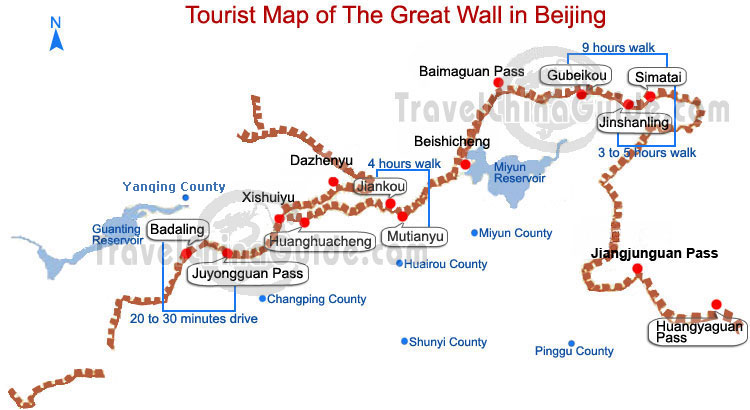Beijing Great Wall
Almost every tourist includes the Great Wall on their must-visit list when traveling to China, and Beijing stands out as the premier destination for experiencing it.
In Chinese history, Beijing held the status of not merely one of the ancient capitals but also ranked among the most pivotal strategic locations in the north. To safeguard the territory, numerous rulers were eager to order the construction of the Great Wall here. Coincidentally, the north and west of Beijing are mountainous regions with complex and perilous terrains. These mountains provided an ideal natural foundation for the Great Wall's construction, enabling it to be built along ridges and key passes, enhancing its defensive capabilities.
Spanning 573 kilometers (356 miles) within Beijing, 526 kilometers (327 miles) of the Great Wall were constructed during the Ming Dynasty (1368 - 1644), stretching across various suburban areas. Here, you can find a diverse range of sections. There's Badaling, the most iconic; Mutianyu and Jinshanling, renowned for their beauty; Simatai and Jiankou, known for their steep terrains; and Huanghuacheng, famous for its unique underwater Great Wall. No matter what kind of Great Wall scenery you want to enjoy, Beijing can offer you the best choice.
Read more: Great Wall of China in Huairou, Beijing
In Chinese history, Beijing held the status of not merely one of the ancient capitals but also ranked among the most pivotal strategic locations in the north. To safeguard the territory, numerous rulers were eager to order the construction of the Great Wall here. Coincidentally, the north and west of Beijing are mountainous regions with complex and perilous terrains. These mountains provided an ideal natural foundation for the Great Wall's construction, enabling it to be built along ridges and key passes, enhancing its defensive capabilities.
Spanning 573 kilometers (356 miles) within Beijing, 526 kilometers (327 miles) of the Great Wall were constructed during the Ming Dynasty (1368 - 1644), stretching across various suburban areas. Here, you can find a diverse range of sections. There's Badaling, the most iconic; Mutianyu and Jinshanling, renowned for their beauty; Simatai and Jiankou, known for their steep terrains; and Huanghuacheng, famous for its unique underwater Great Wall. No matter what kind of Great Wall scenery you want to enjoy, Beijing can offer you the best choice.
Read more: Great Wall of China in Huairou, Beijing
Top 8 Great Wall Sections to Explore in Beijing
1. Mutianyu Great Wall - The Most Popular Section for Foreign Tourists
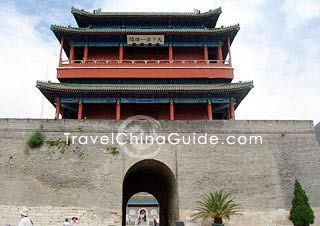 |
| Mutianyu Great Wall |
2. Badaling Great Wall - The Most Famous Section in China
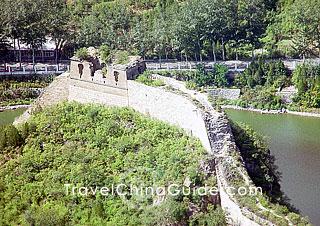 |
| Badaling Great Wall |
3. Juyongguan Great Wall - A Millennium-old Town Encircled by the Great Wall
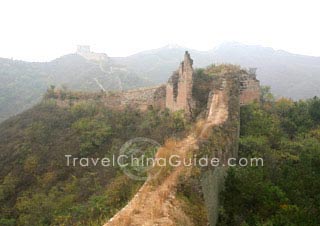 |
| Juyongguan Great Wall |
4. Jinshanling Great Wall - The Most Beautiful and Best-Photographed Section
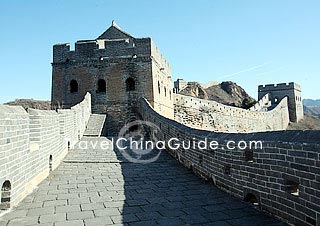 |
| Jinshanling Great Wall |
5. Huanghuacheng Great Wall - The Only Lakeside Great Wall
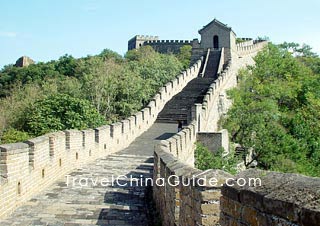 |
| Huanghuacheng Great Wall |
6. Simatai Great Wall - The Best Section for a Night Tour
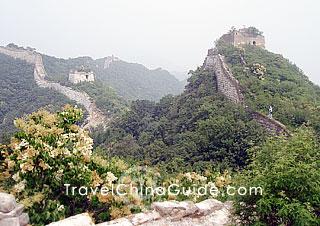 |
| Simatai Great Wall |
7. Jiankou Great Wall - The Wildest and Most Precipitous Section
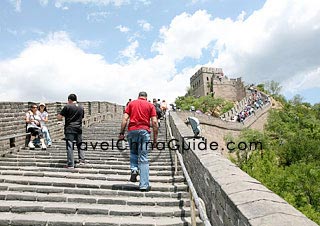 |
| Jiankou Great Wall |
8. Gubeikou Great Wall - The Ideal Section for Hiking Enthusiasts
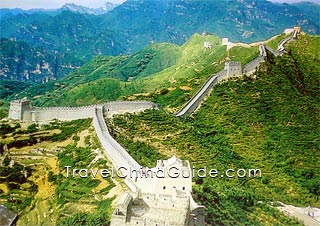 |
| Gubeikou Great Wall |
More sections:
The distance from downtown Beijing to various sections of the Great Wall is approximately 60 - 130 kilometers (40 - 80 miles). You can get to most of these sections from Beijing via public transportation, tour groups, or by renting a car. The following table shows the transportation options available. For more detailed transportation-related information, you can click on the individual page of the specific Great Wall section you are interested in.
| Transportation options | Time required | |
|---|---|---|
| Mutianyu | Tourist Bus, City Bus | 1.5 - 3 hours |
| Badaling | High-Speed Train, Tourist Bus, City Bus, S2 Train | 30 min - 3 hours |
| Juyongguan | Tourist Bus, City Bus | 1.5 - 2 hours |
| Jinshanling | S5 Train, Tourist Bus, City Bus | 2 - 3 hours |
| Huanghuacheng | Tourist Bus, City Bus | 2 - 3 hours |
| Simatai | Tourist Bus, S5 Train | 2.5 - 3.5 hours |
| Jiankou | City Bus | 2.5 - 3.5 hours |
| Gubeikou | S5 Train, City Bus | 3.5 - 4 hours |
![]() See also
See also
How to Get to Great Wall from Beijing Airport
How to Get to Badaling from Downtown
How to Get to Mutianyu from Downtown
Best Places to See Great Wall of China
Please hover over the names on the following tourist map to learn more about the famous sections:
The Current Situation of the Great Wall in Beijing: Coexistence of Protection and Challenges
However, some other sections that remain underdeveloped or are situated in remote areas are in a concerning state. Owing to long-term exposure to natural elements like wind, rain, and earthquakes, the wall has issues such as cracking, collapse, and weathering. Some bricks and stones have dropped off, undermining the wall's stability. Human-induced damage has also inflicted substantial harm on the Great Wall. There are still some tourists who scribble and litter randomly on it. Additionally, some local residents have removed bricks and stones from the Great Wall for construction purposes, causing damage to this historical relic.
What Efforts Have Been Made to Protect the Great Wall?
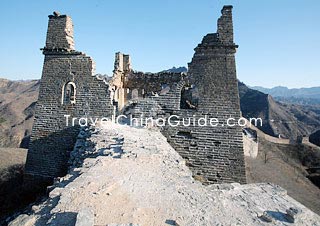 |
| Great Wall Restoration Activity |
2. Regular inspections and law enforcement measures are conducted to severely crack down on illegal activities, including unauthorized climbing of unexplored sections and illegal excavation of bricks and stones from the Wall.
3. Professional conservation teams and experts are organized to take targeted repair measures, tailored to the degree and characteristics of damage in different sections of the Wall.
4. Specialized institutions for the protection and management of the Great Wall have been established, with a clear division of responsibilities, to ensure unified and effective management of protection work.
5. Various activities, such as publicity campaigns, cultural exhibitions, and public lectures, are held to educate the public about the historical and cultural value of the Great Wall and to promote protection knowledge, thereby enhancing public awareness and support.
6. The importance and successful models of Great Wall protection are widely promoted through social media platforms. These platforms serve to expose damaging acts and to guide public opinion towards greater attention and support for the protection of this iconic heritage site.
- Last updated on Apr. 17, 2025 by Sule Su -
